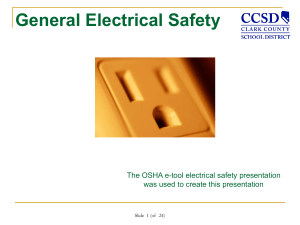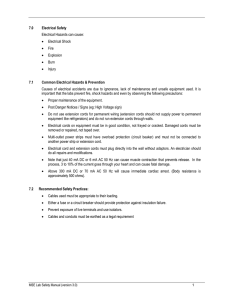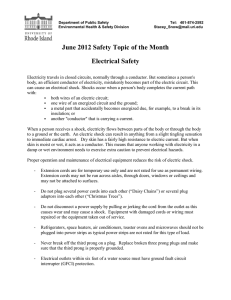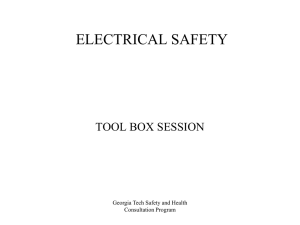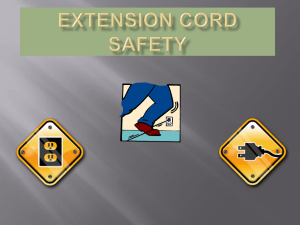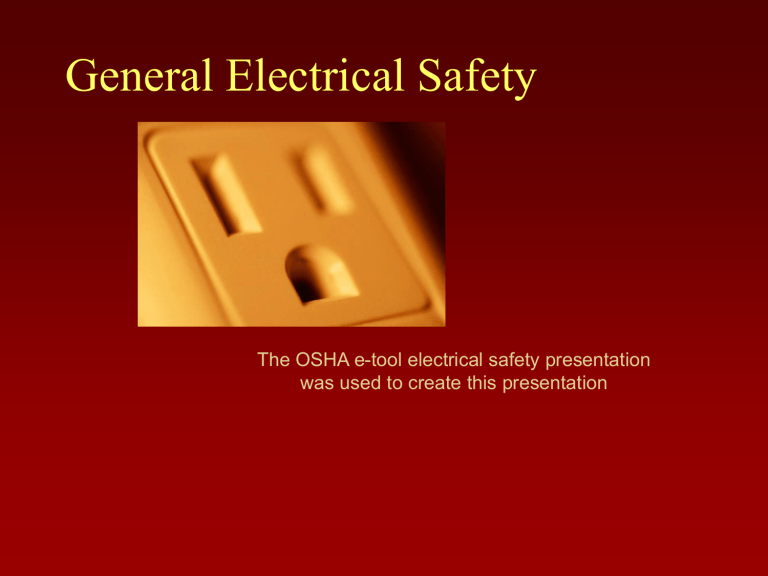
General Electrical Safety The OSHA e-tool electrical safety presentation was used to create this presentation Training Objectives Describe how electricity works Describe how shocks occur Describe how electrical current affects the body Describe the most common ways individuals are injured using electricity Provide solutions to avoid being injured while using electricity How Electricity Works Example: A Garden Hose To Low Pressure Water Moves from High Pressure The same thing occurs in an Electrical Wire Flow of Current Current Moves from High Voltage To Low Voltage Electrical Shocks Electricity travels in closed circuits, normally through a conductor Shock results when the body becomes part of the electrical circuit Current enters the body at one point and leaves at another Note: Ground circuits provide a path for stray current to pass directly to the ground, and greatly reduce the amount of current passing through the body of a person in contact with a tool or machine that has an electrical short. Properly installed, the grounding conductor provides protection from electric shock. How Electrical Current Affects the Body Current (Amps) Human Reaction 0.001 Perception level. Just a faint tingle. 0.005 Slight shock felt; not painful but disturbing. Average individual can let go. 0.006-0.025 (Women) Painful shock, muscular control is lost. 0.009-0.030 (Men) This is called the freezing current or "let-go" range. 0.050-0.150 Extreme pain, respiratory arrest, severe muscular contractions. 1 - 4.3 10 Ventricular fibrillation. Cardiac arrest, severe burns and probable death. Note: some smaller microwave ovens use 10.0 Amps (10,000 milliamps) and common florescent lights use 1 Amp (1,000 milliamps) Burns The most common shock-related injury is a burn. Burns suffered in electrical incidents may be one or more of the following three types: Electrical Burns cause tissue damage, and are the result of heat generated by the flow of electric current through the body. Electrical burns are one of the most serious injuries you can receive and need to receive immediate medical attention. High temperatures near the body produced by an electric arc or explosion cause Arc or Flash Burns (also need prompt medical attention) Thermal Contact Burns occur when skin comes in contact with overheated electric equipment, or when clothing is ignited in an electrical incident. Note: the graphic pictures were not included. But if you would like to view them click http://www.osha.gov/SLTC/etools/construction/electrical_incidents/burns.html Internal Injuries Our bodies use small electrical currents to transmit signals through the nervous system and contract muscles, Extra electrical current flowing through the body can cause serious damage. Medical problems can include internal bleeding, tissue destruction, and nerve or muscle damage. Internal injuries may not be immediately apparent to the victim or observers; however, left untreated, they can result in death Involuntary Muscle Contraction Muscles violently contract when stimulated by excessive amounts of electricity These involuntary contractions can damage muscles, tendons, and ligaments, and may even cause broken bones. If the victim is holding an electrocuting object, hand muscles may contract, making it impossible to drop the object. Note: injury or death may result from a fall due to muscle contractions. Water and Conduction Conductors- Substances with relatively little resistance to the flow of electrical current (e.g., metals). Water- influences the conductive properties of some materials Dry wood is a poor conductor Wood saturated with water becomes a ready conductor Use extreme caution when working with electricity where there is water in the environment or on the skin. Human Skin & Resistance Dry Conditions Human Skin is Resistant Current = Volts/Ohms = 120/100,000 = 1mA (0.001A) -Barely perceptible level of current Wet Conditions Skin’s Resistance drops dramatically Current = Volts/Ohms = 120/1,000 = 120mA (0.12A) -Sufficient current to cause ventricular fibrillation A low voltage electrocution becomes much more hazardous in a wet condition High voltage electrical energy greatly reduces the body's resistance by quickly breaking down human skin. Once the skin is punctured, the lowered resistance results in massive current flow. Low Voltage = Hazardous Muscular contraction caused by stimulation does not allow a victim to free himself from a circuit The degree of injury increases with the length of time the body is in the circuit. Thus even relatively low voltages can be extremely dangerous. LOW VOLTAGE DOES NOT IMPLY LOW HAZARD! An exposure of 100mA for 3 seconds can cause the same amount of damage as an exposure of 900mA for .03 seconds Ground-Faults (The Most Common Form of Electrical Shock) A ground-fault occurs when current flowing to the load (drill, saw, etc.) does not return by the prescribed route. In a simple 120 volt circuit, current travels through the black (ungrounded) wire to the load and returns to the source through the white (grounded) wire. If some or all of the current does not travel back through the white wire then it has gone somewhere else, usually to ground. A person’s body can act as the path to ground when a fault occurs. Ground-Fault Incidents Use GFCI’s for protection against ground-faults 1. A double insulated drill (no ground pin) was used in a wet location. Water entered the drill housing and current flowed through the water and user, and then back to its source. 2. An individual with moist hands was electrocuted while winding up a damaged extension cord when their skin contacted exposed wiring in the extension cord. (This fatality occurred in Utah) Ground-Fault Protection The ground-fault circuit interrupter (GFCI) works by comparing the amount of current going to and returning from equipment along the circuit conductors. When the amount going differs from the amount returning by approximately 5 milliamperes, the GFCI interrupts the current within as little as 1/40 of a second. Note: A GFCI will not protect you from line contact hazards (i.e. a person holding two "hot" wires, a hot and a neutral wire in each hand, or contacting an overhead power line). However, it protects against the most common form of electrical shock hazard, the ground-fault. It also protects against fires, overheating, and destruction of wire insulation. Ground-Fault Protection Use ground-fault circuit interrupters (GFCIs) on all 120-volt, single-phase, 15- and 20-ampere receptacles that will be used to supply temporary power (i.e. hand tools and other portable equipment). -Portable GFCIs, like this one, are available for situations where GFCI protection is not otherwise providedFollow manufacturers' recommended testing procedure to insure GFCIs are working correctly. Important - Plug this end directly into the electrical source, not another flexible cord. Grounding - How Do I Avoid Hazards Ground all power supply systems, electrical circuits, and electrical equipment Do not remove ground pins/prongs from cord- and plug-connected equipment or extension cords Use double-insulated tools Ground all exposed metal parts of equipment Avoid Contact With Power Lines Locate power lines in your work area before you begin working Prior to digging, call 1-800-662-4111 to have utilities identify and mark any buried lines. Keep yourself and all objects at least 10-feet away from all energized power lines. Have power lines de-energized and grounded prior to beginning your work. Use non-conductive ladders (fiberglass) and other tools. Using Equipment in a Manner Not Prescribed By The Manufacturer If electrical equipment is used in ways for which it is not designed, you can no longer depend on safety features built in by the manufacturer. This may damage property and cause employee injuries or worse Shock, fire, loss of life and property? Note: Junction boxes such as this one must be mounted properly. Common Examples of Equipment Used in A Manner Not Prescribed Using multi-receptacle boxes designed to be mounted by fitting them with a power cord and placing them on the floor. Fabricating extension cords with ROMEX® wire. Using equipment outdoors that is labeled for use only in dry, indoor locations. Using circuit breakers or fuses with the wrong rating for overcurrent protection, e.g. using a 30-amp breaker in a system with 15- or 20-amp receptacles (protection is lost because it will not trip when the system's load has been exceeded). Using modified cords or tools, e.g., removing face plates, insulation, etc. Using cords or tools with worn insulation or exposed wires. REMEMBER - ONLY USE EQUIPMENT IN A MANNER PRESCRIBED BY THE MANUFACTURER Flexible Cords Not Used Properly The following cords are improperly wired directly to the electrical circuit, are not protected by a GFCI, and are two-wire cords that are not grounded and not rated for hard- or extra-hard service. Temporary (flexible wiring) must not be used in place of permanent wiring. Multioutlet surge protection such as this can be used to supply power to equipment that needs surge protection, but not used to provide more outlets due to the lack of permanent wiring. Note: a common OSHA violation. Extension type cords that are not 3-wire type, not designed for hard-usage, or that have been modified, increase your risk of contacting electrical current, and must not be used at BYU. Flexible Cord Safe Practices Only use factory-assembled cord sets. Use only extension cords that have a ground wire (3-wire type). Use only extension cords that are marked with a designation code S, ST, SO, and STO for hard service, and SJ, SJO, SJT, and SJTO for junior hard service. Use only cords, connection devices, and fittings that are equipped with strain relief. Remove cords from receptacles by pulling on the plugs, not the cords. Remove from service flexible cords that have been modified or damaged Protect flexible cords from damage. Remember •Visually inspect all electrical equipment before use. •Remove any equipment with frayed cords, missing ground prongs, cracked tool casings, etc. from service. •Apply a warning tag to any defective tool and do not use it until it has been properly repaired. OSHA e-Tool OSHA’s e-tool can be viewed online at: www.osha.gov/SLTC/etools/construction/electrical_incidents /mainpage.html End of General Electrical Safety Document your Training Document and receive credit for your training by completing the General Electrical Safety Quiz and turning it into your supervisor. Lab specific training must also be documented.
